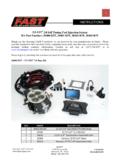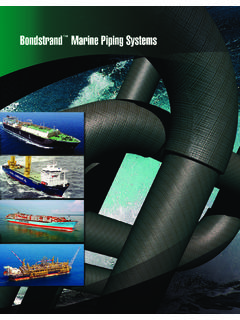Transcription of APPLIED THERMODYNAMICS TUTORIAL 4 PISTON ENGINES
1 APPLIED THERMODYNAMICS TUTORIAL 4 PISTON ENGINES In this TUTORIAL you will do a comprehensive study of PISTON engine cycles and all matters associated with these ENGINES required for the examination. On completion of this TUTORIAL you should be able to do the following. Calculate the fuel power of an engine. Calculate the brake power of an engine. Calculate the indicated power of an engine. Calculate the various efficiencies of an engine. Calculate the Mean Effective Pressure of an engine. Describe the standard thermodynamic cycles for spark and compression ignition ENGINES . Solve standard cycles. First we will examine engine testing methods. 2 1. ENGINE TESTING fuel POWER ( ) fuel power is the thermal power released by burning fuel inside the engine. = mass of fuel burned per second x calorific value of the fuel . = mf x All ENGINES burn fuel to produce heat that is then partially converted into mechanical power.
2 The chemistry of combustion is not dealt with here. The things you need to learn at this stage follow. AIR fuel RATIO This is the ratio of the mass of air used to the mass of fuel burned. Air fuel Ratio = ma/mf STOICHIOMETRIC RATIO This is the theoretical air/ fuel ratio which is required to exactly burn the fuel . TRUE RATIO In reality, the air needed to ensure complete combustion is greater than the ideal ratio. This depends on how efficient the engine is at getting all the oxygen to meet the combustible elements. The volume of air drawn into the engine is theoretically equal to the capacity of the engine (the swept volumes of the cylinders). The mass contained in this volume depends upon the pressure and temperature of the air. The pressure in particular, depends upon the nature of any restrictions placed in the inlet flow path.
3 ENGINES with carburettors work by restricting the air flow with a butterfly valve. This reduces the pressure to less than atmospheric at inlet to the cylinder and the restriction of the inlet valve adds to the affect. ENGINES with turbo charging use a compressor to deliver air to the cylinders at pressures higher than atmospheric. The actual mass of air which enters the cylinder is less than the theoretical value for various reasons such as warming from the cylinder walls, residual gas left inside and leaks from the valves and around the PISTON . To deal with this we use the concept of EFFICIENCY RATIO. Efficiency Ratio = Actual mass/ Theoretical mass 3 CALORIFIC VALUE This is the heat released by burning 1 kg of fuel . There is a higher and lower value for fuels containing hydrogen. The lower value is normally used because water vapour formed during combustion passes out of the system and takes with it the latent energy.
4 We can now define the fuel power. fuel POWER = Mass of fuel /s x Calorific Value VOLUME FLOW RATE A two stroke engine induces the volume of air once every revolution of the crank. A 4 stroke engine does so once every two revolutions. Induced Volume = Capacity x speed for a 2 stroke engine Induced volume = Capacity x speed/2 for a 4 stroke engine. WORKED EXAMPLE A 4 stroke carburetted engine runs at 2 500 rev/min. The engine capacity is 3 litres. The air is supplied at bar and 15oC with an efficiency ratio of The air fuel ratio is 12/1. The calorific value is 46 MJ/kg. Calculate the heat released by combustion. SOLUTION Capacity = m3 Volume induced = x (2 500/60)/2 = m3/s Using the gas law pV = mRT we have Ideal air m = pV/RT = x 105 x (287 x 288) = kg/s Actual air m = x = kg/s.
5 Mass of fuel mf = = kg/s Heat released = calorific value x mf = 46 000 kJ/kg x kg/s = KW 4 SELF ASSESSMENT EXERCISE A 4 stroke carburetted engine runs at 3 000 rev/min. The engine capacity is 4 litres. The air is supplied at bar and 10oC with an efficiency ratio of The air fuel ratio is 13/1. The calorific value is 45 MJ/kg. Calculate the heat released by combustion. (Answer 149 KW) 5 BRAKE POWER Brake power is the output power of an engine measured by developing the power into a brake dynamometer on the output shaft. Dynamometers measure the speed and the Torque of the shaft. The Brake Power is calculated with the formula = 2 NT where N is the shaft speed in rev/s T is the torque in N m You may need to know how to work out the torque for different types of dynamometers.
6 In all cases the torque is T = net brake force x radius The two main types are shown below. Figure 1 Figure 2 Figure 1 shows a hydraulic dynamometer which absorbs the engine power with an impeller inside a water filled casing. Basically it is a pump with a restricted flow. The power heats up the water and produces a torque on the casing. The casing is restrained by a weight pulling down and a compression spring balance pushing down also. The torque is then (F + W) x R. Figure 2 shows a friction drum on which a belt rubs and absorbs the power by heating up the drum which is usually water cooled. The belt is restrained by a spring balance and one weight. The second equal weight acts to cancel out the other so the torque is given by T = F R. Another form of dynamometer is basically an electric generator that absorbs the load and turns it into electric power that is dissipated in a bank of resistor as heat.
7 6 INDICATED POWER This is the power developed by the pressure of the gas acting on the pistons. It is found by recording and plotting the pressure against volume inside the PISTON . Such diagrams are called indicator diagrams and they are taken with engine indicators. The diagram shows a typical indicator diagram for an internal combustion engine. Modern systems use electronic pressure and volume transducers and the data is gathered and stored digitally in a computer and then displayed and processed. Figure 3 The average force on the PISTON throughout one cycle is F where F = MEP x Area of PISTON = pA The Mean Effective Pressure p is the mean pressure during the cycle. The work done during one cycle is W = Force x distance moved = F L = pAL L is the stroke and this is twice the radius of the crank shaft.
8 The number of cycles per second is N. The Indicated Power is then = pLAN per cylinder. Note for a 4 stroke engine N = 1/2 the shaft speed. MEAN EFFECTIVE PRESSURE The mean effective pressure is found from the indicator diagram as follows. The area enclosed by the indicator diagram represents the work done per cycle per cylinder. Let this area be Ad mm2. The average height of the graph is H mm. The base length of the diagram is Y mm. The hatched area is equal to Ad and so Ad = YH H =Ad/Y In order to convert H into pressure units, the pressure scale (or spring rate) of the indicator measuring system must be known. Let this be Sp kPa/mm. The MEP is then found from MEP = Sp H This is also known as the Indicated Mean Effective Pressure because it is used to calculate the Indicated Power.
9 There is also a Brake Mean Effective Pressure (BMEP) which is the mean pressure which would produce the brake power. BP = (BMEP) LAN The BMEP may be defined from this as BMEP = BP/LAN 7 EFFICIENCIES BRAKE THERMAL EFFICIENCY This tells us how much of the fuel power is converted into brake power. BTh = INDICATED THERMAL EFFICIENCY This tells us how much of the fuel power is converted into brake power. ITh = MECHANICAL EFFICIENCY This tells us how much of the indicated power is converted into brake power. The difference between them is due to frictional losses between the moving parts and the energy taken to run the auxiliary equipment such as the fuel pump, water pump, oil pump and alternator. Hmech = 8 WORKED EXAMPLE A 4 cylinder, 4 stroke engine gave the following results on a test bed. Shaft Speed N = 2 500 rev/min Torque arm R = m Net Brake Load F = 200 N fuel consumption mf = 2 g/s Calorific value = 42 MJ/kg Area of indicator diagram Ad = 300 mm2 Pressure scale Sp = 80 kPa/mm Stroke L = 100 mm Bore D = 100 mm Base length of diagram Y = 60 mm.
10 Calculate the , , , MEP, BTh, ITh,and mech, SOLUTION BP = 2 NT = 2 x (2500/60)x (200 x ) = kW FP = mass/s x = kg/s x 42 000 kJ/kg = 84 kW IP = pLAN p = MEP = Ad/Y x Sp = (300/60) x 80 = 400 kPa IP = 400 x x ( x ) x (2500/60)/2 per cylinder IP = kW per cylinder. For 4 cylinders IP = x 4 = kW BTh= = ITh = = % mech= = 80% 9 SELF ASSESSMENT EXERCISE 1. A 4 stroke spark ignition engine gave the following results during a test. Number of cylinders 6 Bore of cylinders 90 mm Stroke 80 mm Speed 5000 rev/min fuel consumption rate dm3/min fuel density 750 kg/m3 Calorific value 44 MJ/kg Net brake load 180 N Torque arm m Net indicated area 720 mm2 Base length of indicator diagram 60 mm Pressure scale 40 kPa/mm Calculate the following.













